“My great-grandmother used to say, ‘Idle hands are the devil’s workshop,’ ” says Provincetown artist R.C. Patterson, “so I like to keep busy.”
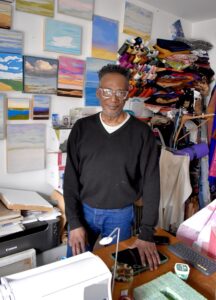
Patterson’s space at the Foley House on Bradford Street, where he has lived since 2014, is both a sewing room and a painting studio, with a bed. The Foley House is Provincetown’s congregate assisted living facility for people living with HIV or AIDS.
His sewing machine sits on a dropleaf wooden table that takes up a quarter of the room. Jars of paintbrushes line the windowsill. An iron rests atop a dresser next to a pile of navy fabric. “Everyone in the Foley House has a different setup,” he says. “We’re all different. This is what I do.”
Patterson’s paintings, photographs, and mixed-media works hang salon-style on the walls. Some aren’t finished. “I keep saying, ‘Is it finished?’ ” he says. “It isn’t finished.”
He pulls two quilts from a stack next to his bed. The first is white with pink triangles, burnt orange rectangles, and maroon-striped peach patches. The second is a maze of shapes and colors with a leaf-patterned faded pink arrow, blocks of muted maroon, Army-green rectangles, triangular navy gingham patches, patterned black ovals, and a blood-red trapezoid.
Patterson was born in Brooklyn, N.Y. His father worked for a law firm that represented artists Jackson Pollock and Mark Rothko. “He wasn’t a lawyer, but he worked there,” he says. He remembers standing on a chair and looking at a chartreuse painting by Rothko. “One of the lawyers came out and asked me what I liked about the painting, and I said, ‘I like the red in it.’ ”

“ ‘What red?’ the lawyer said, and then he got really close and he saw the base layer of red underneath the chartreuse,” says Patterson. “It was hard to see — you had to get really close up. That’s what I like about getting close to paintings now — you get to see how something was made. I was four years old, but I knew I had something.”
He remembers being in elementary school when the other kids were drawing cats using circles and thinking, “A cat doesn’t look like that.” He says he was dyslexic and struggled in school. “But by third grade I knew I was a good artist.”
Patterson studied at the Art Students League of New York from 1979 to 1986 with painter and assemblage artist Bruce Dorfman. He learned encaustic, printing, and painting. A job at the board of education paid for his art classes at York College. He left the city in 1988 for the College of Santa Fe, where he got his B.F.A.
Patterson’s first season in Provincetown was 2005. He worked at Artstrand. “Bob Bailey was the art director, and I was his gallery assistant,” he says.
In the years that followed, he sold paintings at Gallery 444; he also worked as a housekeeper and selling ferry tickets. These days he works as a sexton at the Methodist Church on weekends and pet-sits, along with his art and sewing practices. Patterson is represented by Gallery 411. He had a solo show of his quilts at the Provincetown Commons in 2021.
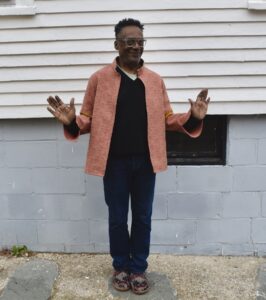
“Some people think I live a charmed life because I’m not doing much,” he says. “I get up and take photos every morning and sit by the waterfront near St. Mary’s. Not a lot of people can do that. I don’t take it for granted. It’s a moment of meditation in the summer before the day gets busy. I have that quiet time by myself.”
Patterson says there’s no one artist he would name as a model. “I don’t feel I’ve been influenced by anyone,” he says. “Oh, but I like Mark Rothko. And Jasper Johns.”
Producer Jordan Roth and the Young Emperors influence his clothing designs, he says. “Sometimes he’ll wear her clothes and she’ll wear his clothes — the clothes are kind of unisex. When I’m sewing, I’m not thinking about male or female. I’m thinking about something I would wear — a skirt or a pair of pants or a jacket.”
Patterson holds up a jacket he made using repurposed synthetic fabric. “I’m not that social, and I don’t go out, but if I did, this is what I’d be wearing,” he says. “I’m going to have to start wearing these clothes, but I’m just kind of shy. When I went to PAAM, I wore my technicolor dreamcoat, but I got too much attention. I’ve always been low-key. The last time I was interviewed was 1992.”
Patterson made Collusion, a woven mixed-media work from 2019, in a fit of anger at President Trump. “This is a political piece made with paper,” he says. “The Russian flag and United States flag are mixed into each other — the hammer and sickle and the stars.”
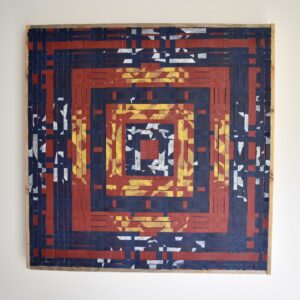
He had worked as a draftsman all through high school. “It was before autoCAD,” he says. “I learned with triangles and pencils how to draft architectural and mechanical drawings.” His first job was for Atlantic Exhibit Services, which did trade shows and exhibitions. “I would draw the floor plan — where all the vendors would be,” he says.
Patterson worked on a plan for the old Commodore Hotel above Grand Central Station when Trump bought it. “Trump’s people changed measurements, and I had to alter the floor plan,” he says. “It wasn’t legal — Donald Trump is like that. I went to see the foreman, and there was a commotion because Trump was coming. I was ushered out of view.” Patterson says the reason he was given was that “everyone knows Donald Trump doesn’t like Black people.”
Woven Print #2 is another geometric woven piece using acrylic gold leaf on paper. The work hangs on the wall above Patterson’s bed. “When I weave, everything tends to be symmetrical,” he says. “I like order.”
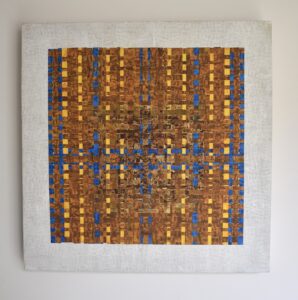
For Morning Bathe, Patterson took the photograph and printed it on fabric. In the foreground, two women swim in Provincetown Harbor. The signature shape and line of houses on the waterfront pattern the background. Patterson captured the exact moment the two women touched. “It made me think of Michelangelo,” he says.
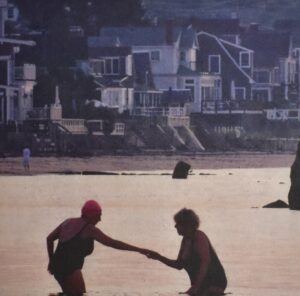
Molar is a mixed-media piece with a central compartment for a tooth Patterson had to have extracted five years ago. The tooth sleeps in a small green medicine jar. Behind the jar is a green tile backdrop. The cave is surrounded by woven canvas.
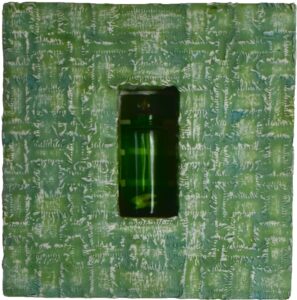
“I have more,” says Patterson. “I always knew I had more of something. I’m able to keep myself busy.”



